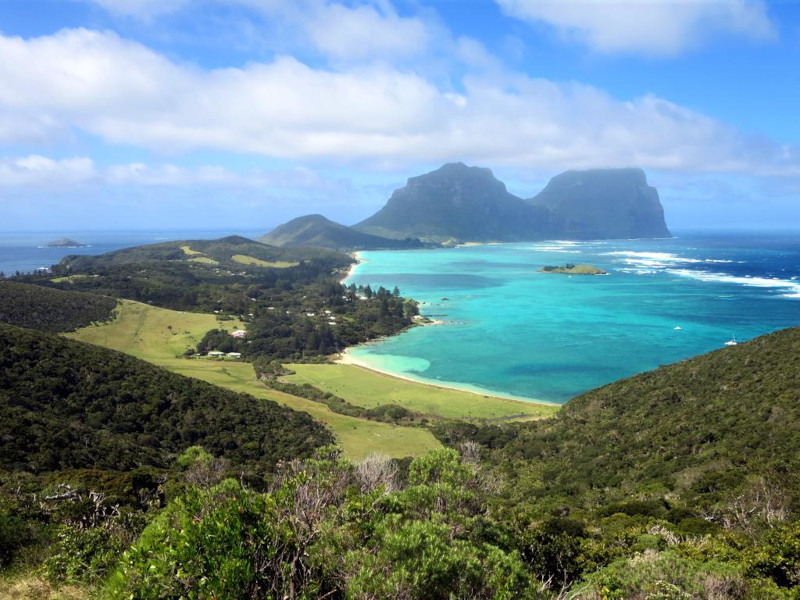Lord Howe Island Facts
- The fabulous Lord Howe Island remains a little known marvel of Nature. It also plays a far greater role than many who learn of it might believe. This holds true due to a combination of several factors. Most of these revolve around its varied ecosytems.
- The first known sighting of this isle took place on 17 February, 1788. At that time, Lieutenant Henry Lidgbird Ball, commander of the HMS Supply, spotted the island. The ship earlier left Botany Bay, traveling to Norfolk Island, to form a penal colony.
- On his return trip, he claimed it as a possession of the British Empire. Shortly thereafter, due to its location, it became an important provisioning outpost for whaling activities in the region. This remained the case until whaling declined in the 1880’s.
- Subsequent to the loss of that revenue, the global exportation of a local plant became the principle commerce of the island. For a short period of time, the international sale of the indigenous Kentia palm, native to only this island and one other, flourished.
- Although that trade remains, in a reduced state, another industry grew, following the close of World War II. After that period, tourism quickly became a flourishing, and profitable business. It continues to be the leading source of revenue for the island.
- The breathtaking Lord Howe Island hosts a number of flora and fauna found nowhere else in the world. The same also holds true for many of the other islands in its group. In 1982, UNESCO therefore listed the remarkable island as a World Heritage Site.
Related Articles
Lord Howe Island Physical Description
Perhaps the most amazing thing about the awesome Lord Howe Island is the fact that it packs all its wonder into a relatively small area. That’s due to the fact that this incredible creation of geological processes has an area equaling only 5.62 sq mi (14.55 sq km).
The site also has a highly irregular shape, though the overall pattern resembles that of a crescent moon. Its length measures approximately 6.2 mi (10 km) in length. Its width, however, varies from as little as 0.19 mi (0.3 km) to only as much as 1.24 mi (2 km).
An area along the western coast of the island holds a partialy enclosed coral reef lagoon. The island further boasts a total of 11 beaches, though the one in the coral reef lagoon stands out in terms of beauty. That’s because of the presence of bright white sand.
Despite its small area, Lord Howe Island also holds two mountains of relatively great height. Volcanic in origin, both sit in the southern portion of the isle. Mount Lidgbird measures 2,549 ft (777 m) in height. Mount Gower, however, measures 2,871 ft (875 m).
Between the two peaks lies Erskine Valley, itself a thing of great beauty. This valley further remains heavily forested even today. The lovely Erskine Creek also flows through the valley. Over its course, several small yet beautiful waterfalls dot the tropical landscape.
Lord Howe Island Location, Formation, and Biodiversity
The natural marvel known to man as Lord Howe Island formed in a comparatively remote region of the globe. The island, along with its accompanying 27 small islands, islets, and rocks, lies in a region of the Tasman Sea. This puts it in the South Pacific Ocean.
More precisely, the magical location sits between the continent of Australia, and the island nation of New Zealand. Its location places the site roughly 320 mi (600 km) directly east of the town of Port Macquarie. It’s also 490 mi (900 km) southwest of Norfolk Island.
This phenomenal site formed as result of volcanic activity. It’s actually the extremely eroded remnants of an ancient shield volcano. That volcano appeared roughly 7 million years ago. That ancient feature formed as a result of regular eruptions over a 500,000 year period.
The various features of the island formed at different times, though. The central and northern hills came first, around 6.9 million years ago. Mount Lidgbird and Mount Glower, however, formed about 600,000 years later. They’ve since become highly eroded.
The site further boasts a wet, subtropical climate. Partly due to this, flora and fauna flourish. The majority of the area of the island remains a virtually untouched forest. Further augmenting its distinctiveness, a full 44% of the local plantlife appears nowhere else.
A phenomenal total of 202 different species of birds appear on the island. Many live there, while others use it as a migratory stopover. Numerous reptilian species live there, but only one native mammalian species remains. That’s the Large forest bat.
Many invertebrates call Lord Howe Island home, most found nowhere else. The astounding Lord Howe Island Stick Insect once called the island home. It’s since disappeared from the main island, however. It now appears only on nearby Ball’s Pyramid in the wild.
Features Sharing Its Region
Check out our other articles on 4 Scintillatingly Shaded Snakes, Orange Peel Doris, Chocolate Chip Sea Star, Pritchardia kaalae, Skeleton Shrimp, Postojna Cave, Giant Girdled Lizard

